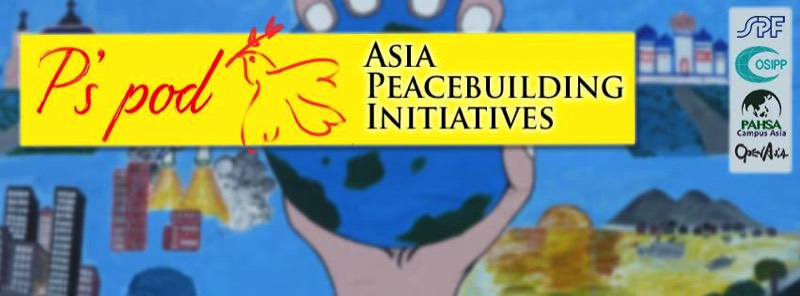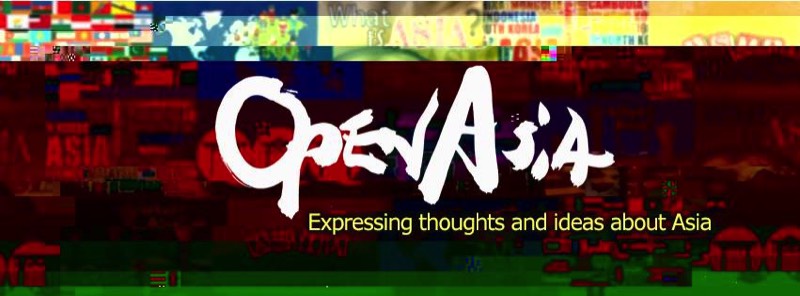Essays: PAHSA Aceh Short Program
Syiah Kuala University, Banda Aceh, Indonesia, played host to the third PAHSA short-term study program, 7-18 October, 2012. Students from partner universities attended the international symposium “Strengthening Peace and Human Security in Asia.” In addition to the special symposium, there were also additional lectures and field trips organized by Syiah Kuala University where students could learn about the particular human security issues faced locally. Below are some of the reports written by PAHSA students on the program.
Aceh: an abundance of knowledge
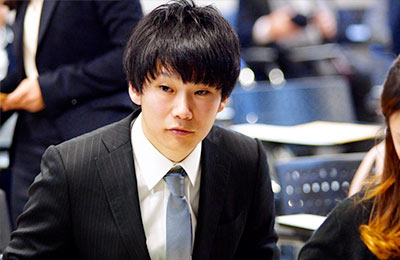
OSIPP, Osaka University, Japan
Although the two-weeks of the Aceh short study program passed quickly, I could never have expected so many new experiences in such a short time. These included captivating lectures, visiting interesting sights, experiencing new cultures, and of course, meeting new people and building friendships. All of these will go on to influence me a great deal and I could say much about this. However, with a limited number of words, I would like to focus on three main points in this essay, these are; 1) my initial motivation and expectation before participating on the program, 2) to what degree were my expectations met or exceeded, and, 3) others things that I gained through going to Aceh.
Motivation and Expectations
When applying for the program, in my mind I attempted to correlate my research topic with the Aceh program and map out some clear questions in order to aid my research. My research question is “Why has Japan been failing to establish diplomatic relations with North Korea?” and “How can they be achieved in the future?” Initially while considering these thorny issues, my approach was to analyze the concepts of national security with human security at the forefront. Here I have written in the past tense because this has been slightly modified and my research question itself might still yet change, although the overall theme, the Japan/North Korea nexus will most likely remain central as my research concern. With this in mind, as Aceh had suffered the tsunami disaster as well as having experienced long term conflict, I thought the issues surrounding the process of peace building and reconstruction, including human security concerns, and the involvements of civil society and NGOs, would be valuable future references in my research arena.
Experience Gained
As perhaps most might surmise, there are few places in the world with the issues, challenges and unique circumstances like those found in regards to North Korea. In the case of Aceh, where particular problems or circumstances might have been comparable to some degree, it would be somewhat simplistic to think that any solution to Aceh’s problems might be applied wholesale in the case of North Korea. There are many differences, cultural, political, geopolitical, historic, as well as other issues in regards to international relations. Yet still, there was much to be learnt in Aceh. Lectures in the area of gender issues (especially the rights of women) were illuminating, so too were those on the role of NGOs. Each of these topic areas brought focus on how these issues might be navigated from the macro perspective. Moreover, there was something more significant to be learnt through the program, that is, the importance of fieldwork.
All information needs to be judged for bias, that is, an inclination or prejudice for or against one group or viewpoint. What one can learn subjectively from written materials can sometimes be limited, especially when information is tightly controlled or sensationalized. Honest and timely interpretation of specific situations or facts might only be possible from the field. Although I have never done fieldwork, on the program there were many chances to speak to those who had been in the field and could share their experience. It became clear that in social science, sometimes sitting behind a desk is no substitute for being there on the ground.
All information needs to be judged for bias, that is, an inclination or prejudice for or against one group or viewpoint. What one can learn subjectively from written materials can sometimes be limited, especially when information is tightly controlled or sensationalized. Honest and timely interpretation of specific situations or facts might only be possible from the field. Although I have never done fieldwork, on the program there were many chances to speak to those who had been in the field and could share their experience. It became clear that in social science, sometimes sitting behind a desk is no substitute for being there on the ground.
Positive Effects
There was an abundance of knowledge to be learnt and shared on the Aceh program, and with its acquisition, we became richer individuals and better equipped to play a part in helping and understanding others. The program proved to me that with knowledge and in its application, there could be wisdom. My experience through the study program was a conduit for this process in my future study. One of the students on the program who had experienced the tsunami and the conflict said “Because of the disaster and the conflict, we can get to know people from Japan, like you.” This remark struck a chord and will stay with me into the future. Such a snapshot was typical of the Aceh program. I believe the things I learnt and experienced through the program, and the knowledge that was shared, will provide positive effects as my research takes place in the days ahead.
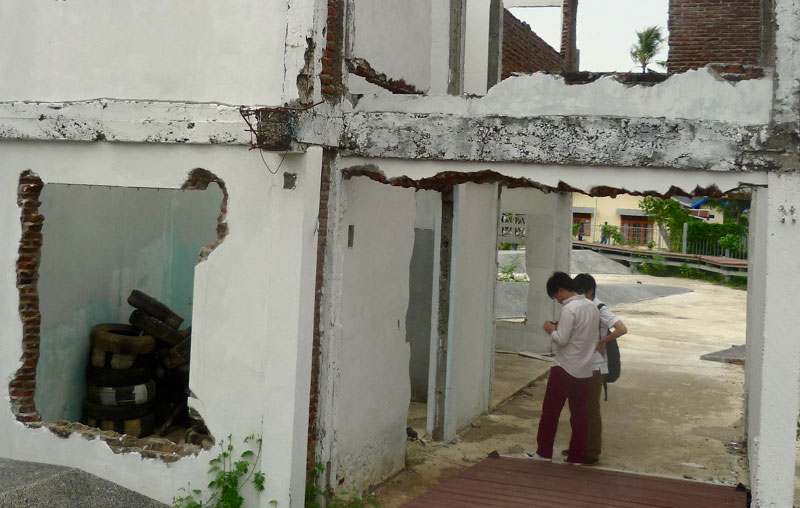
PAHSA students view a damaged building saved as a memorial from the 2004 tsunami.
A Process of Discovery
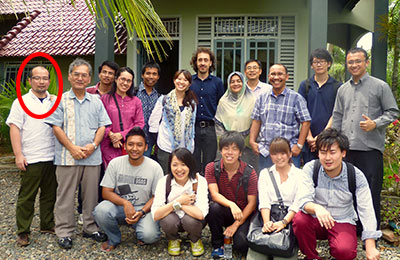
IDEC, Hiroshima University, Japan
The short-term study program that took place at Banda Aceh in August 2012 proved to be illuminating. It shone a spotlight on one critical area for my personal research, the Free Aceh Movement (Gerakan Aceh Merdeka or simply GAM in Indonesian). The Aceh insurgency was a drawn out affair that ebbed and flowed from 1976 until the peace agreement with the Indonesian government in 2005. It is thought over 15,000 people lost their lives over that period. The Indonesian government called the group the Aceh Security Disturbance Movement, yet this title cloaked the group’s intentions – to fight for independence for the Aceh region from Indonesia.
Sometimes, guerrilla groups that fight for independence construct an aura around them and I was not immune to the effects of this. On the outset, I generally thought about the group in positive terms before my trip to Aceh. It was soon clear that as a student researching the Aceh conflict and the process of peace, some of my impressions of GAM had been somewhat colored by the reporting of the conflict and my own presumptions. Yet after spending time on the ground, speaking to local people, fellow students and academics, I had to re-evaluate my opinions somewhat and have tried to bring more impartiality to my standpoint.
Since independence from the Dutch in the mid 20th century, Aceh felt a growing disillusionment with its mistreatment by the Indonesian Javanese-dominated government. There was also dissent over Islamic laws, unhappiness over the distribution of wealth from natural resources, as well other societal issues causing unhappiness. With this growing unease, the GAM movement was born in the mid 1970s. It saw ups and downs until the 2005 peace agreement was signed and its armed wing was disbanded.
Like many, I thought GAM was welcomed and needed by most Acehnese people to fight for their rights and improve their living situation. But when speaking to those people, it was soon obvious that this was not so clear-cut. It seems that GAM, a paramilitary guerrilla organization, employed questionable tactics in its struggle. Some Acehnese were critical of this and talked about extortion and heavy-handed behavior from the group. Some people also questioned the overt military focus of the organization. Certainly, the local people felt the brunt of their actions as threats and extortion seem to have been the order of the day for some. But even if these accounts are true, GAM’s contribution to the independence movement should not be discounted, especially when the organization gained much wider support by ordinary people in the post Suharto era. Yet many intellectuals that I met on the study tour remained skeptical and questioned GAM’s mode of operations. Perhaps support for GAM in Banda Aceh where we were based may have been sketchy because it was not an original GAM stronghold. Further research is needed to understand this complex relationship, especially to gauge the feeling of ordinary people on a wider scale.
I think the greatest thing about the study program in Banda Aceh was the communication that took place. The communication that took place with professors, local people, and other students on the program was invaluable. I came to quickly realize that my views and opinions could be somewhat myopic or lack balance in certain areas. On the program, the different backgrounds and experience in others’ lives made it possible for me to assess my own thoughts and open my mind to new ideas. It was also highly motivating. Living and learning together for more than 10 days led to a close connection and an enhanced respect for others’ views. With this experience, I will renew my own research efforts with increased vigor and openness thanks to the PAHSA program.
Sometimes, guerrilla groups that fight for independence construct an aura around them and I was not immune to the effects of this. On the outset, I generally thought about the group in positive terms before my trip to Aceh. It was soon clear that as a student researching the Aceh conflict and the process of peace, some of my impressions of GAM had been somewhat colored by the reporting of the conflict and my own presumptions. Yet after spending time on the ground, speaking to local people, fellow students and academics, I had to re-evaluate my opinions somewhat and have tried to bring more impartiality to my standpoint.
Since independence from the Dutch in the mid 20th century, Aceh felt a growing disillusionment with its mistreatment by the Indonesian Javanese-dominated government. There was also dissent over Islamic laws, unhappiness over the distribution of wealth from natural resources, as well other societal issues causing unhappiness. With this growing unease, the GAM movement was born in the mid 1970s. It saw ups and downs until the 2005 peace agreement was signed and its armed wing was disbanded.
Like many, I thought GAM was welcomed and needed by most Acehnese people to fight for their rights and improve their living situation. But when speaking to those people, it was soon obvious that this was not so clear-cut. It seems that GAM, a paramilitary guerrilla organization, employed questionable tactics in its struggle. Some Acehnese were critical of this and talked about extortion and heavy-handed behavior from the group. Some people also questioned the overt military focus of the organization. Certainly, the local people felt the brunt of their actions as threats and extortion seem to have been the order of the day for some. But even if these accounts are true, GAM’s contribution to the independence movement should not be discounted, especially when the organization gained much wider support by ordinary people in the post Suharto era. Yet many intellectuals that I met on the study tour remained skeptical and questioned GAM’s mode of operations. Perhaps support for GAM in Banda Aceh where we were based may have been sketchy because it was not an original GAM stronghold. Further research is needed to understand this complex relationship, especially to gauge the feeling of ordinary people on a wider scale.
I think the greatest thing about the study program in Banda Aceh was the communication that took place. The communication that took place with professors, local people, and other students on the program was invaluable. I came to quickly realize that my views and opinions could be somewhat myopic or lack balance in certain areas. On the program, the different backgrounds and experience in others’ lives made it possible for me to assess my own thoughts and open my mind to new ideas. It was also highly motivating. Living and learning together for more than 10 days led to a close connection and an enhanced respect for others’ views. With this experience, I will renew my own research efforts with increased vigor and openness thanks to the PAHSA program.
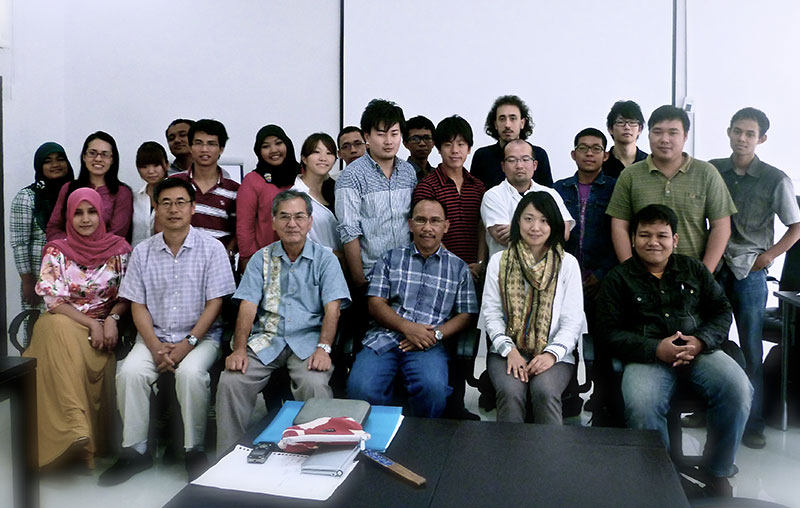
PAHSA students and professors at Syiah Kuala University, Banda Aceh.
Build Back Better: Who is creating your community space?
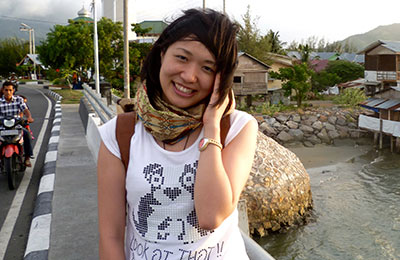
OSIPP, Osaka University, Japan
"26 December 2004, the very huge Tsunami attacked my grandma's house and washed away all things," … nervously smiling, a student from Aceh's Syiah Kuala university, told me in a whisper.
Today, a cursory glance around Aceh reveals little of her story. The sights look clean; reconstruction is orderly, and the great infrastructure such as roads look sound and tough. It is hard to believe that such an enormous catastrophe had befallen the area.
As an undergraduate, my university major was “community design” which is part of city or town planning. During this time, I visited rural areas often, especially rural farm villages in Japan. These opportunities offered a good deal of experience. But the most lasting lesson is how difficult it is to understand a region's problems at the local level, and then identify ways to improve the situation with the use of the region’s own resources. Certainly, the involvement of the local people is key in empowering a region’s improvement. This is especially true in the wake of devastation following a huge natural disaster when everything is often destroyed.
Moving forward, my Master thesis analyzes the Great 2011 East Japan earthquake using economic theories. The paper’s goal is to identify the culture of giving: why people donate, what kind of people they are, how they might volunteer, and how their efforts bring relief to the victims of disasters. Flows of money and support from all over the world have become an unexceptional phenomenon when disasters occur. The stimulus from these efforts has the power to create new towns or living environments for those affected. But this process is never straightforward. At home, there is much discussion among the Japanese how to make best use of the donations for reconstructing after the Great East Japan earthquake.
When one considers the situation in Aceh, the good work of constructing houses and rebuilding communities has been reported several times since the Tsunami aid efforts. ARUP - an independent firm of designers, planners and engineers - focused squarely on the practical realties of delivering a successful rebuilding program. A book was produced about their efforts and there have been exhibitions of photos and workshops focusing on the locals’ housing and about how creating sustainable jobs were at the forefront in reconstruction aims. Other organizations such as JAROE (Indonesian local NGO) reported on how traditional Acehnese women’s industries were reestablished having been funded by aid from the Japanese government (Embassy of Japan in Indonesia 2007).
The rebuilding process is still ongoing. But looking around Aceh, we do not need to see statistics to know that the issue of unemployment or underemployment is still to be fully addressed. JAROE’s projects have been very important for some women, but others are still at home. It is fairly clear that Aceh’s native resources are still being underutilized. Yet for some, along with the new infrastructure there is also hope. But is this enough? The roads in the main town looked clean. Many Acehnese said, “JICA made this” (Japan Cooperation Agency). One wonders at what level the citizens were involved in the town planning process, and if not, are the donations from the world being spent in the best way? Similar questions are brewing over the reconstruction in Tohoku, Japan, following the devastating earthquake and tsunami.
In Tohoku, perhaps we do not need to construct a memorial park or any kind of memorial right now, especially after citizens have been forced to move to a place where they do not want to be. Of course, conveying the importance and the way the disaster will shape the region going forward is something that should be done. But the key thing first must be to create jobs and support sustainable lives for the citizens. This is just as true in Japan as it is in Aceh. Yet the degree of planning or the amount of control ceded to outsiders is a complex thing. Following the Aceh tsunami, local fishermen rebuilt their houses once more right next to the sea. As an outsider, one might worry about their well-being after such a decision. Yet for them, by doing this, the Aceh fisherman reestablished their community and ensured the gainful employment that they need to move forward. This is a post-recovery paradox, and one that only the local people might fully understand.
Returning to the question posed by my paper, why do people donate and volunteer to help victims? The answers here are varied and too complex to summarize at this stage. But when disaster strikes, many people are urged to do something and to think about what they can do for the victims. This feeling generates an enormous amount of money and help on the ground and this capital needs to be used wisely to benefit the locals. Creating a sustainable community space and jobs are very difficult tasks, but fortunately, NGOs and other civil organizations are starting to recognize the importance of these things.
My time in Aceh was short. I was not able to see physically the devastation that the area had suffered. However, the fact remains that an enormous tsunami is estimated to have killed 170,000 people and left half a million homeless. People still have sorrow in their hearts and I searched for my own way to help. I’m still searching for the solution, but for now, I will just listen and share in some of the pain. I never want to forget my new friends, and I never will forget the story from the nervously smiling student in Aceh.
Today, a cursory glance around Aceh reveals little of her story. The sights look clean; reconstruction is orderly, and the great infrastructure such as roads look sound and tough. It is hard to believe that such an enormous catastrophe had befallen the area.
As an undergraduate, my university major was “community design” which is part of city or town planning. During this time, I visited rural areas often, especially rural farm villages in Japan. These opportunities offered a good deal of experience. But the most lasting lesson is how difficult it is to understand a region's problems at the local level, and then identify ways to improve the situation with the use of the region’s own resources. Certainly, the involvement of the local people is key in empowering a region’s improvement. This is especially true in the wake of devastation following a huge natural disaster when everything is often destroyed.
Moving forward, my Master thesis analyzes the Great 2011 East Japan earthquake using economic theories. The paper’s goal is to identify the culture of giving: why people donate, what kind of people they are, how they might volunteer, and how their efforts bring relief to the victims of disasters. Flows of money and support from all over the world have become an unexceptional phenomenon when disasters occur. The stimulus from these efforts has the power to create new towns or living environments for those affected. But this process is never straightforward. At home, there is much discussion among the Japanese how to make best use of the donations for reconstructing after the Great East Japan earthquake.
When one considers the situation in Aceh, the good work of constructing houses and rebuilding communities has been reported several times since the Tsunami aid efforts. ARUP - an independent firm of designers, planners and engineers - focused squarely on the practical realties of delivering a successful rebuilding program. A book was produced about their efforts and there have been exhibitions of photos and workshops focusing on the locals’ housing and about how creating sustainable jobs were at the forefront in reconstruction aims. Other organizations such as JAROE (Indonesian local NGO) reported on how traditional Acehnese women’s industries were reestablished having been funded by aid from the Japanese government (Embassy of Japan in Indonesia 2007).
The rebuilding process is still ongoing. But looking around Aceh, we do not need to see statistics to know that the issue of unemployment or underemployment is still to be fully addressed. JAROE’s projects have been very important for some women, but others are still at home. It is fairly clear that Aceh’s native resources are still being underutilized. Yet for some, along with the new infrastructure there is also hope. But is this enough? The roads in the main town looked clean. Many Acehnese said, “JICA made this” (Japan Cooperation Agency). One wonders at what level the citizens were involved in the town planning process, and if not, are the donations from the world being spent in the best way? Similar questions are brewing over the reconstruction in Tohoku, Japan, following the devastating earthquake and tsunami.
In Tohoku, perhaps we do not need to construct a memorial park or any kind of memorial right now, especially after citizens have been forced to move to a place where they do not want to be. Of course, conveying the importance and the way the disaster will shape the region going forward is something that should be done. But the key thing first must be to create jobs and support sustainable lives for the citizens. This is just as true in Japan as it is in Aceh. Yet the degree of planning or the amount of control ceded to outsiders is a complex thing. Following the Aceh tsunami, local fishermen rebuilt their houses once more right next to the sea. As an outsider, one might worry about their well-being after such a decision. Yet for them, by doing this, the Aceh fisherman reestablished their community and ensured the gainful employment that they need to move forward. This is a post-recovery paradox, and one that only the local people might fully understand.
Returning to the question posed by my paper, why do people donate and volunteer to help victims? The answers here are varied and too complex to summarize at this stage. But when disaster strikes, many people are urged to do something and to think about what they can do for the victims. This feeling generates an enormous amount of money and help on the ground and this capital needs to be used wisely to benefit the locals. Creating a sustainable community space and jobs are very difficult tasks, but fortunately, NGOs and other civil organizations are starting to recognize the importance of these things.
My time in Aceh was short. I was not able to see physically the devastation that the area had suffered. However, the fact remains that an enormous tsunami is estimated to have killed 170,000 people and left half a million homeless. People still have sorrow in their hearts and I searched for my own way to help. I’m still searching for the solution, but for now, I will just listen and share in some of the pain. I never want to forget my new friends, and I never will forget the story from the nervously smiling student in Aceh.
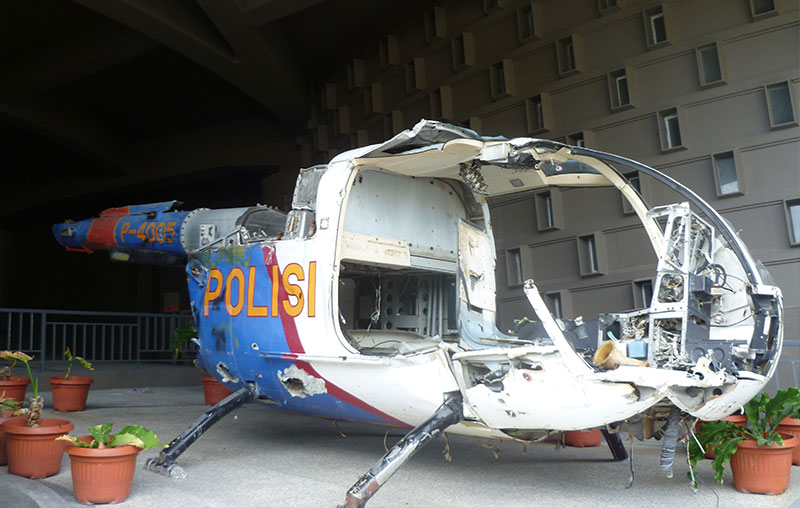
A police helicopter that was destroyed in the 2014 tsunami.
Getting Lives Back On Track
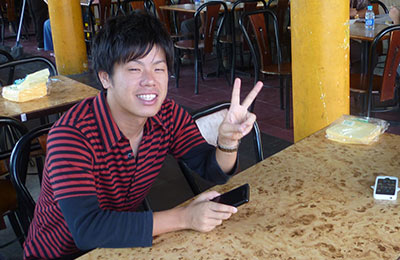
IDEC, Hiroshima University, Japan
I joined the short-term study program at Aceh hoping to find out more about the situation after the tsunami and the peace agreement. Like Aceh, Japan has experienced its own pain. We had a devastating earthquake, the great East Japan earthquake and tsunami in March 2011. With this in the back of my mind, the visit to Aceh would allow me to see how the local people had somehow managed to get their lives back on track following their catastrophes.
The study program took place at Aceh, Indonesia, 7-17 September 2012. For me, this was my first time in the country, and such were the many unforgettable experiences on the program, it is a visit I will never forget. For example, when visiting the tsunami museum, we saw all the history and the analytical data of the tsunami right before us. We also had an opportunity to hear about the tsunami from a woman who was an eyewitness on that fateful day. One could not help but be touched by her narrative – her story was totally authentic. After disasters like tsunamis or huge conflicts, we are taught that we must analyze the events. However, after listening to the eyewitness’ narrative, I realize that we must look beyond the cold hard facts and think about the people and their lives, those that suffer the greatest, because understanding this is key if we want to truly grasp the complexities of such disasters.
While attending the study tour, we also had many opportunities to attend informative theoretical lectures at Syiah Kuala University. As well as these, there were also visits to NGOs and LOGICA (the Local Governance and Infrastructure for Communities in Aceh). These trips were particularly fascinating; there were many opportunities to listen to informative practical talks about the real situation on the ground in Aceh. When we went to LOGICA, I can remember one of their Acehnese staff offering to speak candidly on any issue. This openness was refreshing. And alongside the mood of reconstruction, I felt that the staff member’s candidness echoed that in Aceh, the people seem to be enjoying the spirit of democracy. Democratization is clearly one of the hopes of the people after the hardship they have suffered. Hopes of democracy and having a hand in decision-making are some of the things that the Japanese can share with the Acehnese people.
Of course, with only a relatively short time in Aceh, I could not build great in-depth knowledge of the real Acehnese culture and their lives. Yet on the surface, I felt that the Japanese and Acehnese have many things in common. We have both lived through tragic events and have pulled together in a spirit of rebuilding. During the tour, I was met with nothing but kindness from the local people.
Through this program, I learned a great deal about the devastating effects of the Tsunami and how Aceh has been rebuilt. Friendships were established and I will keep in touch with Acehnese students and the participants on this program. Along with the knowledge gained from the lectures and fieldtrips, these friendships are the most precious thing that I have taken away from the study program.
The study program took place at Aceh, Indonesia, 7-17 September 2012. For me, this was my first time in the country, and such were the many unforgettable experiences on the program, it is a visit I will never forget. For example, when visiting the tsunami museum, we saw all the history and the analytical data of the tsunami right before us. We also had an opportunity to hear about the tsunami from a woman who was an eyewitness on that fateful day. One could not help but be touched by her narrative – her story was totally authentic. After disasters like tsunamis or huge conflicts, we are taught that we must analyze the events. However, after listening to the eyewitness’ narrative, I realize that we must look beyond the cold hard facts and think about the people and their lives, those that suffer the greatest, because understanding this is key if we want to truly grasp the complexities of such disasters.
While attending the study tour, we also had many opportunities to attend informative theoretical lectures at Syiah Kuala University. As well as these, there were also visits to NGOs and LOGICA (the Local Governance and Infrastructure for Communities in Aceh). These trips were particularly fascinating; there were many opportunities to listen to informative practical talks about the real situation on the ground in Aceh. When we went to LOGICA, I can remember one of their Acehnese staff offering to speak candidly on any issue. This openness was refreshing. And alongside the mood of reconstruction, I felt that the staff member’s candidness echoed that in Aceh, the people seem to be enjoying the spirit of democracy. Democratization is clearly one of the hopes of the people after the hardship they have suffered. Hopes of democracy and having a hand in decision-making are some of the things that the Japanese can share with the Acehnese people.
Of course, with only a relatively short time in Aceh, I could not build great in-depth knowledge of the real Acehnese culture and their lives. Yet on the surface, I felt that the Japanese and Acehnese have many things in common. We have both lived through tragic events and have pulled together in a spirit of rebuilding. During the tour, I was met with nothing but kindness from the local people.
Through this program, I learned a great deal about the devastating effects of the Tsunami and how Aceh has been rebuilt. Friendships were established and I will keep in touch with Acehnese students and the participants on this program. Along with the knowledge gained from the lectures and fieldtrips, these friendships are the most precious thing that I have taken away from the study program.
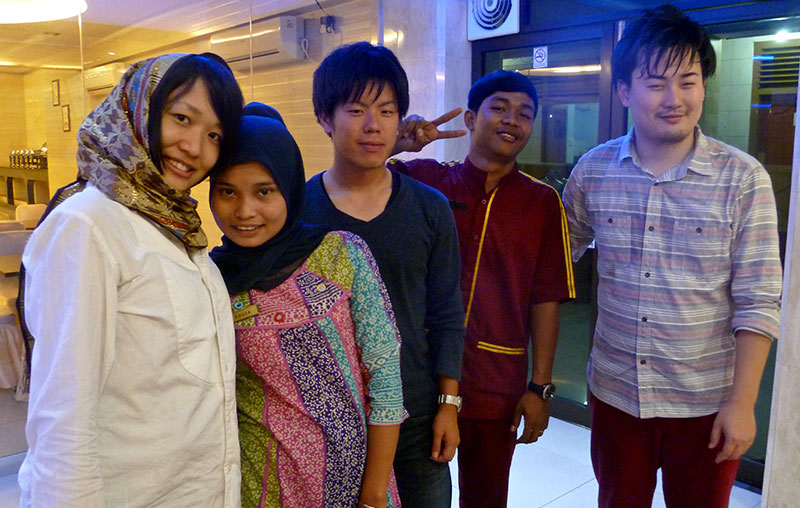
PAHSA students with their Acehnese hosts
PAHSA is part of "Campus Asia." Supported by the Ministry of Education, Culture, Sports, Science and Technology in Japan
Download the PAHSA Brochure
PAHSA sister sites
.gif)
